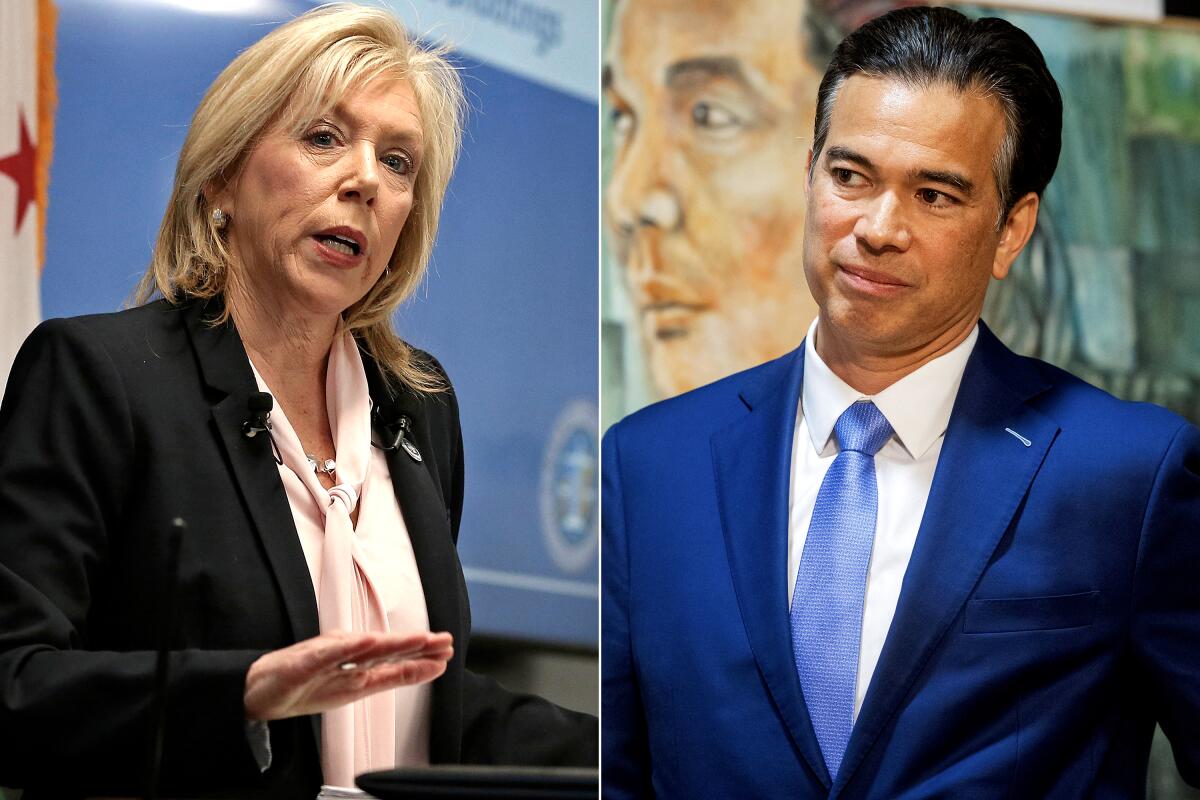California Politics: Five stories to watch in 2022

Given all the political surprises in 2021 for California — a tempestuous but unsuccessful campaign to remove the governor, the historically delayed redrawing of the state’s legislative and congressional maps — it seems especially risky to prognosticate too much about what’s in store for 2022.
Still, there are a few clear storylines emerging about the year ahead in California politics and government. State and local leaders will surely continue to spend much of their time addressing the impacts of a third year of the COVID-19 pandemic, as well as monitoring drought conditions and grappling with the crisis of homelessness. All of it will play out under the shadow of a statewide election, as candidates begin to file paperwork as soon as next week for state and federal races.
As we get settled in for the journey that lies ahead, here are five items worth watching in 2022.
Is the governor’s race a fait accompli?
It would be presumptuous in most years to call the outcome of an election before it’s been held, especially for an office as powerful as that of California governor. This year, though, maybe it’s not.
The failed Sept. 14 recall against Gavin Newsom raises serious questions about the viability of any established challenger to knock the Democratic governor off his perch in November. Newsom didn’t just prevail in the special election to remove him from office, he dominated: 62% of voters rejected the proposal, a rout that was equal in size to his 2018 victory.
The governor’s top Republican challengers had such limited appeal that 42% of all ballots cast were left blank on the question of who should replace Newsom — a total that exceeded the number of votes won by the top GOP contender, Larry Elder.
Elder has been noncommittal about a rematch. Another well-known GOP contender who once seemed certain to run in 2022, former San Diego Mayor Kevin Faulconer, is also keeping mum, perhaps taking a hard look at whether his brand of traditionally centrist Republican politics is still viable in today’s politically polarized climate. Beyond that, it’s awfully hard to see a viable contender on the horizon.
If Newsom has any real challenge in 2022, it might be voter enthusiasm. Elections depend on voters showing up, and it was a statewide poll last summer showing substantial Democratic lethargy that probably helped spark the huge get-out-the-vote effort responsible for quashing the recall.
And there’s also history on Newsom’s side: No California governor has lost a race for reelection since Gov. Culbert Olson in 1942.
Crime and the race for attorney general
The race for governor may leave political watchers yawning, but the election of California’s attorney general has all the markings of a major battle, pitting advocates of criminal justice reform against law-and-order groups.
Atty. Gen. Rob Bonta has been in the job less than a year, appointed by Newsom to fill the vacancy left when Xavier Becerra joined the administration of President Biden. Bonta’s tenure in the Legislature included an array of efforts to rethink the tough-on-crime agenda that dominated in California for more than a generation. His record includes the sweeping 2018 law that sought to end cash bail but was overturned by voters in 2020.
The question is whether Bonta’s track record will become a political liability. Criminal justice concerns have taken on a new urgency after a spate of high-profile smash-and-grab robberies in California cities — brazen crimes that have left Bonta, Newsom and other officials promising action. The incidents probably will boost the campaign of Anne Marie Schubert, the district attorney of Sacramento County, who hopes to unseat Bonta in November. Schubert deftly dropped her Republican Party affiliation in 2018, avoiding the baggage of the GOP brand in California while allowing her to run as a “no party preference” candidate but still receive significant backing from GOP-affiliated groups.
Schubert is already hitting Bonta hard, linking him to L.A. County Dist. Atty. George Gascón and San Francisco Dist. Atty. Chesa Boudin in campaign videos in which she promises to “stop the chaos in our criminal justice system.”
Other candidates are expected, but the race is expected to largely come down to Bonta vs. Schubert. It’s likely to be the most intense contest for attorney general since 2010, when then-Los Angeles County Dist. Atty. Steve Cooley lost by 74,157 votes to the district attorney of San Francisco — better known now, of course, as Vice President Kamala Harris.

Big bucks for ballot measures
California’s airwaves and voters’ social media feeds will be flooded this fall with advertisements supporting or opposing statewide ballot measures.
It’s shaping up to be a big year for initiative campaigns, and tops among them could be the complicated fight over legalizing sports betting in the state, a multi-measure fight that’s already attracted more than $100 million in campaign contributions. Other measures will feature pricey campaigns. Physicians and healthcare groups have socked away more than $29 million in their effort to kill a ballot measure that seeks to loosen the existing cap on medical malpractice awards.
The campaign cash is also piling up for a proposed ballot measure to tax the state’s highest-income earners to fund pandemic detection and prevention programs. And across all of these campaigns, look for some of the early money to be spent on petition drives to collect the voter signatures needed for qualifying a measure.
Spending limit is the budget’s biggest issue
California’s government budget is full of arcane formulas, a sizable number of them placed there by voter-approved ballot measures. One of those mandates, largely invisible in years past, will dominate budget deliberations in 2022.
In its simplest form, it’s a constitutional limit on local and state government spending. Once reached, any excess tax revenues must be diverted to special long-term government expenses or divvied up between public schools and taxpayer rebates. The details, of course, are far more complex. Lawmakers and their fiscal advisors will likely spend months sorting out which expenses are, and aren’t, counted toward what can be spent under the State Appropriations Limit — nicknamed the “Gann limit” after the proponent of the 1979 ballot measure that put it in place, the late anti-tax crusader Paul Gann.
The turnaround in the state’s budget fortunes in recent years has been dramatic. It’s also made the Gann limit suddenly relevant, given that the calculation includes population growth and California is no longer growing like it used to. The spending limit is dynamic and subject to almost constant change. It’s also inherently political and will bear special attention beginning in mid-January when Newsom sends a new budget plan to the Legislature.
Enjoying this newsletter? Consider subscribing to the Los Angeles Times
Your support helps us deliver the news that matters most. Become a subscriber.
Redistricting: Pack your bags or stand your ground
The amendments to the California Constitution that stripped the Legislature of its power to draw political maps explicitly prohibit the state’s redistricting commission from considering where incumbent lawmakers live when drawing the lines.
That’s led to one of the most intriguing subplots of the new legislative and congressional boundaries, with a few sitting members of the Assembly, Senate and House of Representatives drawn into the same districts. Will they pack their bags or stand their ground?
The congressional quandary isn’t as big of a deal, because federal law doesn’t require House members to live in their districts — perhaps best exemplified by Rep. Tom McClintock (R-Elk Grove), whose home in southern Sacramento County is a long way from the Sierra Nevada communities he represents in Washington.
But state law is more strict for Assembly and Senate candidates, who must be eligible to vote in the district they’re running to represent. The maps certified last week by the Citizens Redistricting Commission could result in at least half a dozen Assembly races and a couple of Senate races with incumbents pitted against each other.
A number of incumbents have yet to announce what they’ll do, while at least two legislators seemed to brush it off as no big deal. After Assemblymen Marc Berman (D-Palo Alto) and Evan Low (D-Campbell) were drawn into the same Bay Area district, Low posted a video on social media of the two men settling things by swatting each other with pillows. Berman must have won the pillow fight because, four days later, Low announced he’d run for a newly drawn Assembly district that’s nearby.
Stay in touch
Did someone forward you this? Sign up here to get California Politics in your inbox.
Until next time, send your comments, suggestions and news tips to [email protected].
Sign up for Essential California
The most important California stories and recommendations in your inbox every morning.
You may occasionally receive promotional content from the Los Angeles Times.




